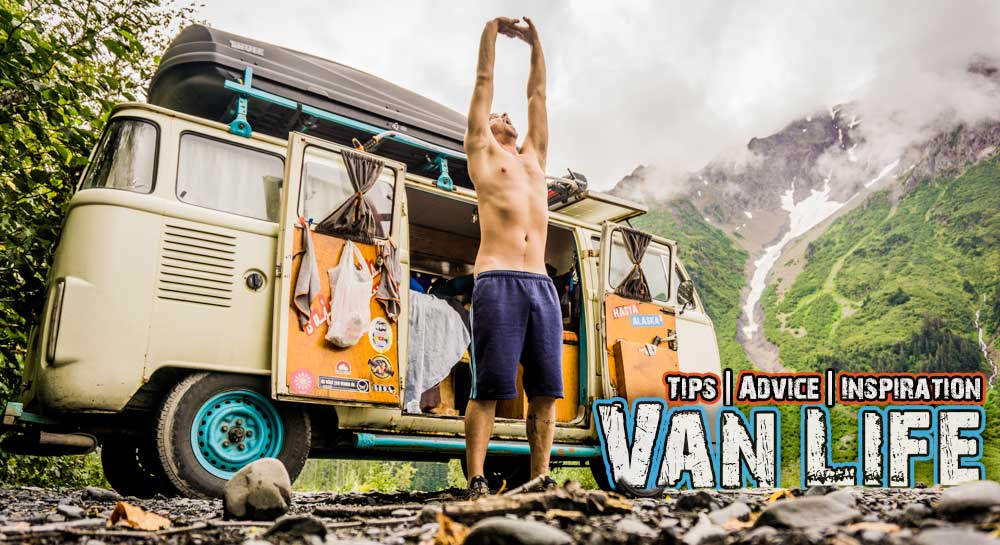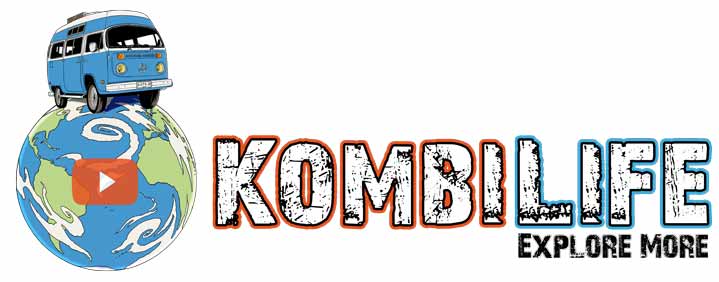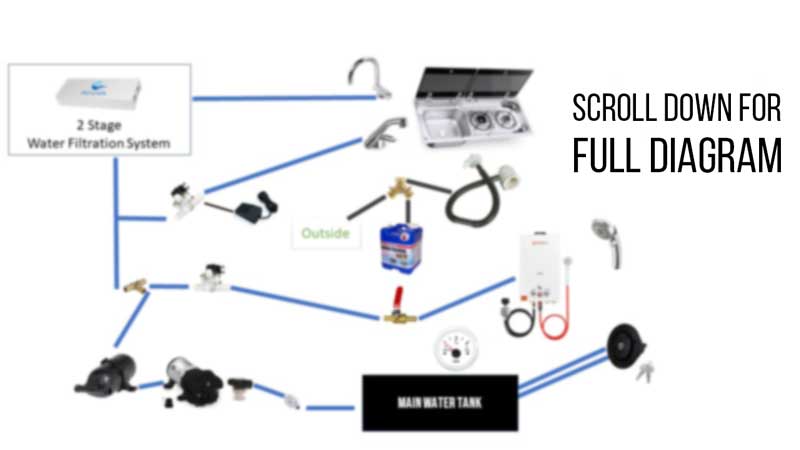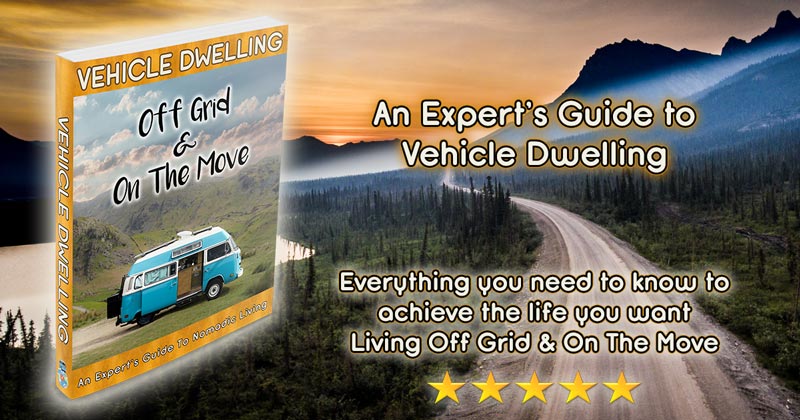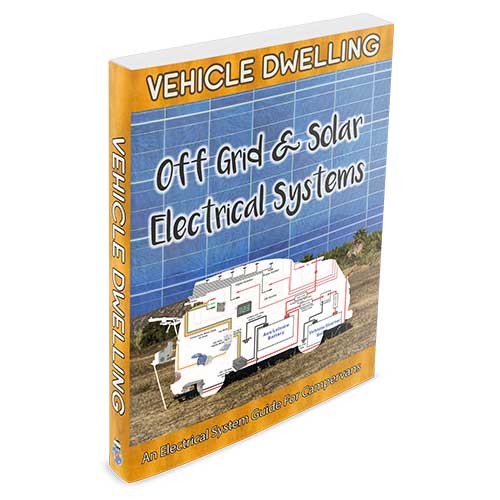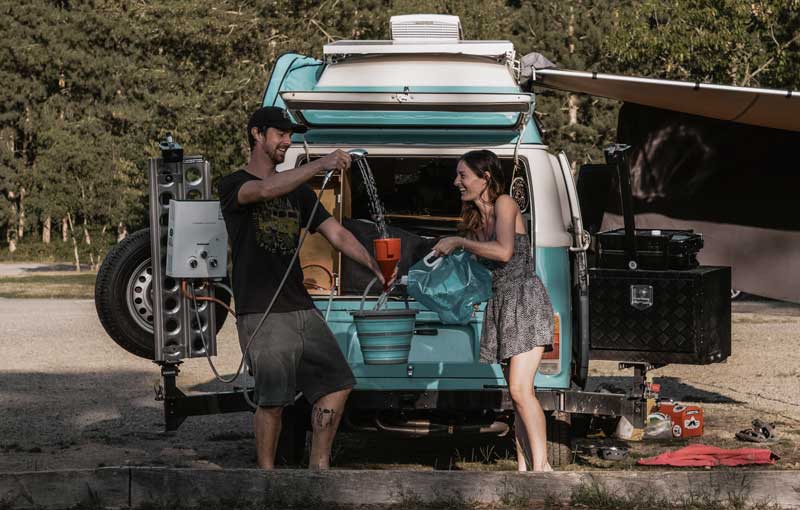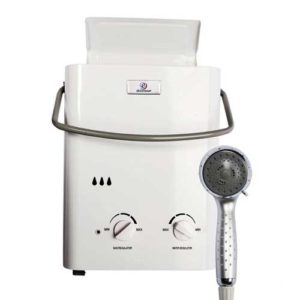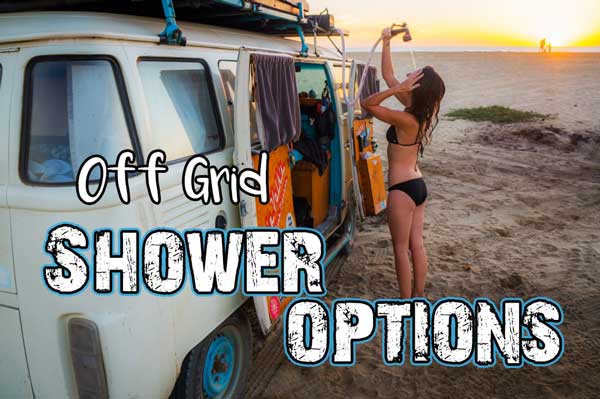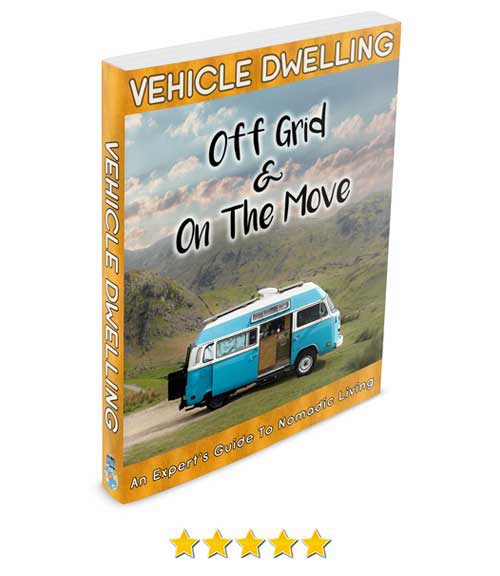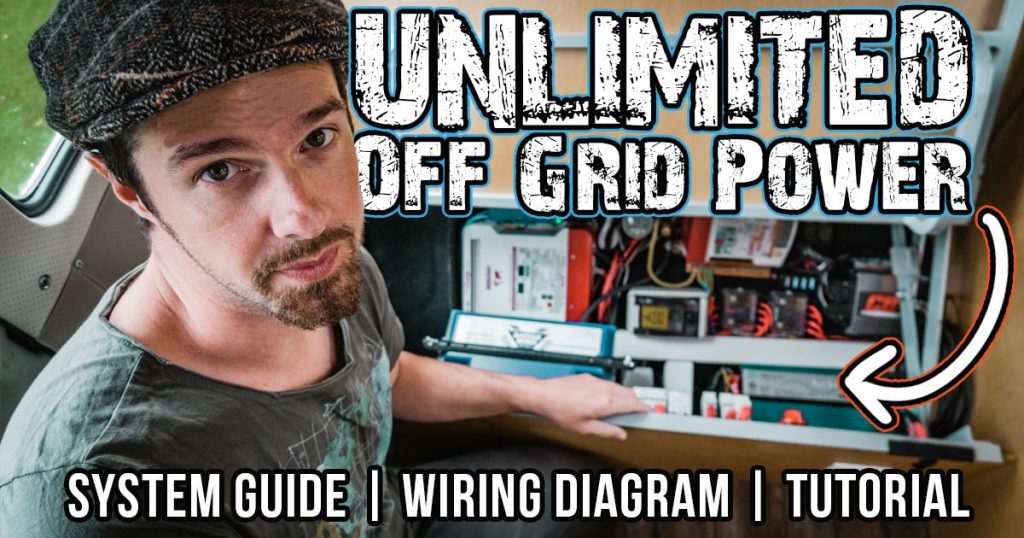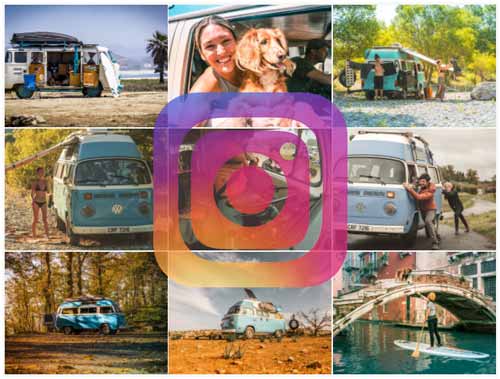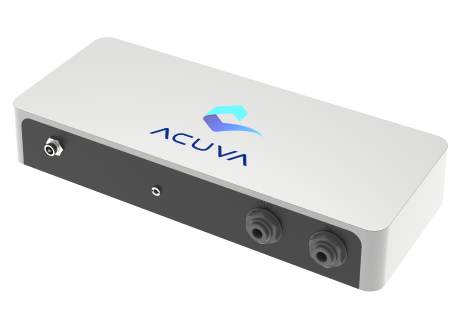Van Life Water System Guide and Diagram
COMPLETE GUIDE TO VAN LIFE WATER SYSTEMS FOR EXTENDED OFF-GRID TRAVEL
Van Life Water systems are a key consideration if you’re thinking about spending time on the road, living in a vehicle, or using it as a base for your adventures.
Doing it right can make your dream of simple living a reality. Doing it wrong can mean you spend more time sourcing and managing water than enjoying the Van Life.
We have been busy building our dream adventure rig for our Overlanding Around The World Travel Series, and so we’ve put in hundreds of hours of research and came up with the best system possible for the needs of a nomadic lifestyle. Here we’re sharing what equipment we used and how we put it all together so you can design a mobile water system for your specific needs.
Van Water System Diagram
CLICK HERE to Jump to the interactive Water system diagram
Complete Guide to Van Life Water Systems
Contents
The importance of Accumulator Tanks
ULTRA SAFE VIRUS KILLING UV Filtered Drinking Water System [HIGHLY RECOMMEND]
Do you have space in your vehicle for a toilet and/or a shower?
Where are you going to keep the extra water storage?
Do you want to deal with black water disposal?
How willing are you to always need to find facilities?
DISCLOSURE:
This post contains affiliate links, which means that if you click a product link and buy anything from the merchant, we will receive a commission fee. The price you pay remains the same with or without the affiliate link
Campervan Water Tanks
Water is the most important asset for your home on wheels. There is no doubt that you will need to store water to drink, to cook with, and to wash with (your dishes and your body).
Individual water containers are easy to refill and don’t require any installation, although they should be secured from moving around whilst you are mobile.
Having a single dedicated tank, securely located low in the vehicle is a good option and is tidier than multiple individual containers. An under-slung tank frees up living space internally but will be more prone to freezing if you are venturing to high altitude or if you will camp in the winter.
Stainless steel tanks are sturdier and more expensive but maybe the best option if you are intending to have an under-slung tank and have your heart set on tackling a fair bit of rough terrain.
Any tank made of plastic must be food grade. If you can find one that does not let in the light it will be better at preventing mold and nastiness from growing inside your tank.
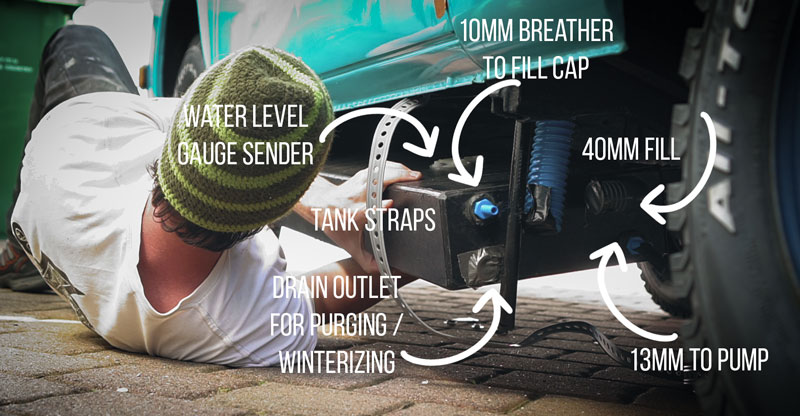
Installing our custom under-slung water tank
What Size Water Tank?
The optimal size of your van water tank depends on you, how many people will be using the supply and what kind of climate you will be in. In hot environments, you’ll typically go through a minimum of 20% more water when you are drinking more and showering more than in cold environments, where you will drink less and perhaps source more indoor hot showers from public facilities.
Your water tank size is often a compromise on your living space. We recommend installing the largest tank that you can to extend your time off-grid at your dream camp spot. If you don’t have space for a very large tank, consider using collapsible water containers or a water bladder to allow you to increase your capacity when you have the need to store more water.
If you are installing a large water tank, or are having one designed for a custom space we recommend the use of baffles in the design which will stop large quantities of water from surging and causing damage as you drive.
Most fixed tanks have the following ports:
FILL – Where you put the wet stuff in
FEED – It goes to the pump’s pre-filter or a check valve
BREATHER – It goes up, preferably to the neck of the fill cap
DRAIN – Attach a valve for maintenance, purge, or winterizing
WATER TANK OPTIONS
Permanently installed water tanks
Under-slung water tanks
Specialist Water Tanks for Van, RV & Boat – (10 to 42 Gallons)

Overlanders benefit from multiple tanks!
Some people use one single source of water for all needs, including drinking. Whilst this is easier, it is more expensive. We like the option of being able to fill a separate tank with non-potable 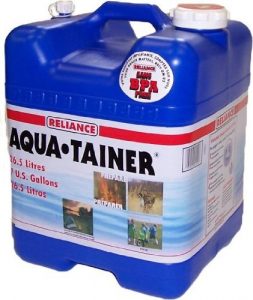 water that we use exclusively for washing dishes and our bodies. We find that we go through more non-potable water than drinking water so for us it makes sense to have these water sources in separate tanks. We use a dedicated 25L (5.5 gallons) drinking water tank which has a breather for ease of use. We always make sure that this tank is kept super clean. Non-potable water is also much easier to find than good drinking water. We recommend keeping these water sources separated if you plan to spend a lot of time off-grid.
water that we use exclusively for washing dishes and our bodies. We find that we go through more non-potable water than drinking water so for us it makes sense to have these water sources in separate tanks. We use a dedicated 25L (5.5 gallons) drinking water tank which has a breather for ease of use. We always make sure that this tank is kept super clean. Non-potable water is also much easier to find than good drinking water. We recommend keeping these water sources separated if you plan to spend a lot of time off-grid.
Our water tanks are kept secure using heavy duty water tank straps
Serious overlanders should also consider a Water Bladder to expand water carrying options when supplies are spare or you just want to stay at that killer camp spot for another few days
Hoses & Filling Your Tanks
Be sure that all hoses used in tanks for potable water are rated as food-grade hoses.
You’ll want the hose you use to fill the tank to be as large as possible so that you can fill it quickly. You’ll also want to ensure that your tank has a breather hose so the air can escape as you fill the water tank otherwise it will fill extremely slowly.
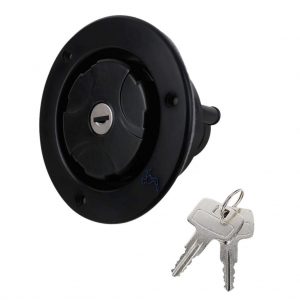
Our filler cap is 40mm (1.5”) with a 10mm (3/8″) breather hose that is magnetic and lockable so we don’t have anyone spiking our water or steeling it when we are parked in the desert. OK, that was a joke, but keeping your water clean isn’t, so just get a lockable cap if you have a hook-up on the outside of your van, OK?!
If you think you will spend a lot of time hooked up to a water supply, like at a campsite, for example, you may wish to get a city water hook up which uses a standard quick release hose connector. We built our camper for off-grid living, so opted for a gravity fill only solution (pictured).
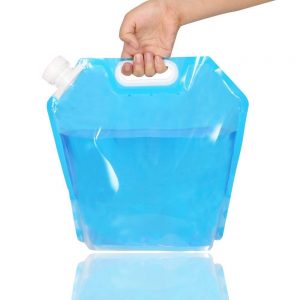
We prefer to fill our tanks from the outside of the vehicle because no matter how careful you are, you will spill some, but maybe you like that and need the encouragement to clean your floor anyway?
Keep in mind if these types of hook-ups on the outside of your vehicle make it more obvious that your vehicle is a campervan; stealth campers will want to avoid this.
We use the above-mentioned flexible water containers to fill our tanks as they store away very conveniently.
We also use this funnel to help fill our tanks, it makes the job quicker and easier and has an inbuilt coarse filter to prevent any bugs from getting into our tanks. You’d be surprised how easy it is for that to happen!
To make filling much easier, it’s a good idea to carry a collapsible travel hose if you will be filling large tanks. Either way, we still recommend that you keep some of those collapsible water bags tucked away for times when you can’t get your vehicle close enough to the faucet.
Measuring & Monitoring Water Capacity
You’ll want to easily be able to ascertain how much water you have at any given moment. Should we fill up now, do we have enough for a shower this morning, etc.
If your water tank is in any way difficult to access we recommend installing a simple water gauge so that you can know at the push of a button what your supply is and how much longer you can stay off-grid. If you want a better gauge, this is the water gauge that we would recommend
Grey Water Tank
Grey water is wastewater, for example from washing dishes, your hands/face, or from brushing your teeth. There is no human waste in grey water and no chemicals, just some soap suds.
We use environmentally friendly camping soaps for all our needs on the road and we would love it if you did too, really, why not?
We use a standard garden ¾” y-valve system for choosing between sending our grey water straight out under our van or into an onboard container that lives under our kitchen sink.
Some of the time we send it straight out under the van but most of the time we catch it in a collapsible bucket which we dispose of every morning down the nearest drain or into a hole we’ve dug.
You really should avoid putting soap suds and food scraps directly onto the floor as it attracts insects and rodents. This is especially important in urban settings or when parked at a frequently visited campsite.
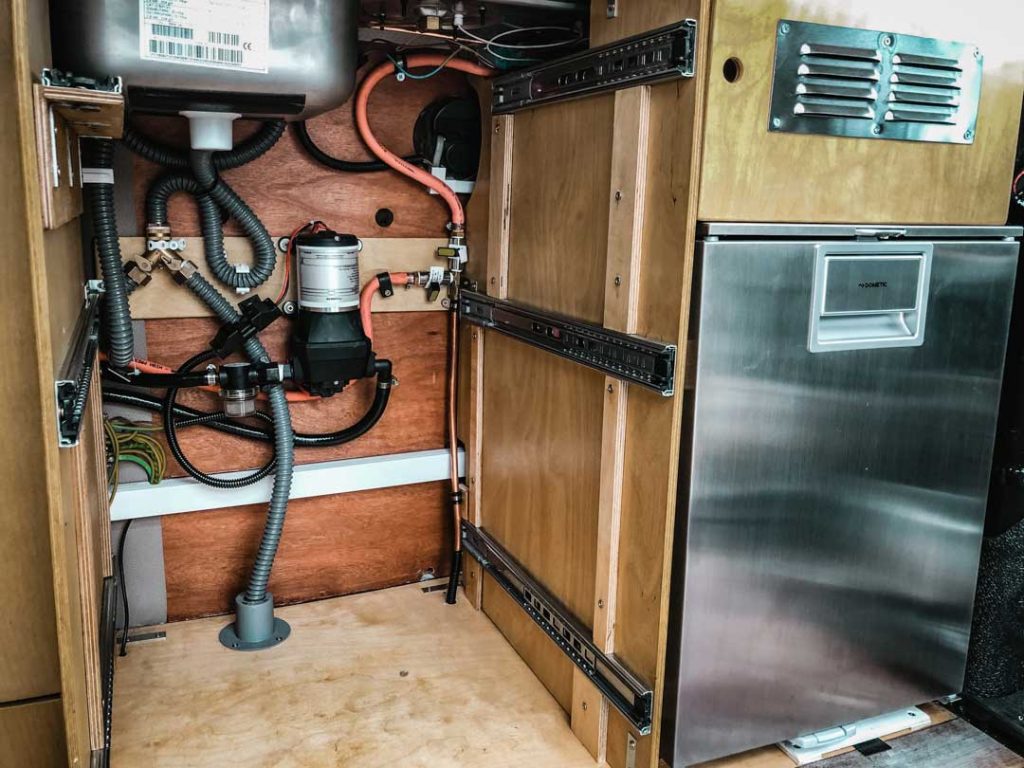
Mobile Home Black Water Systems
Black water contains human waste (Pee and its ugly cousin, Poop). It also contains chemicals. Black water must be dumped at a designated RV dumping station.
We talk more about your options for pooping on the road, including how to avoid having to deal with black water.
Click to read more about Van Life Toilet Options
Winterizing your water tanks
You don’t want to let your tanks or any part of your water system freeze. It’s very easy for the water to expand as it freezes and cracks pipes, pumps, and tanks.
You’ll want to make sure that you can drain all parts of your system easily should it be subject to freezing, which can be done with a drain valve or compressed air.
If you plan to use your camper in freezing conditions, you should ensure that your tanks are inside the camper and you have your heating on. Extra caution should be taken with any parts of the system which are far from a heat source.
Pumping Water in your Camper Van
You can avoid having to install a pump by having your water tank off the ground and letting gravity do the work. It’s generally not the best idea to have a large volume of water high off the deck of the vehicle as it raises the center of gravity and affects the handling of your van; so this option is typically only used by the spartan weekend-warriors of the Van Life world. That said we did live with this system for over 5 years whilst Overlanding from Chile to Alaska during the Hasta Alaska Expedition.
For most people, you will want to pump the water out of your tanks.
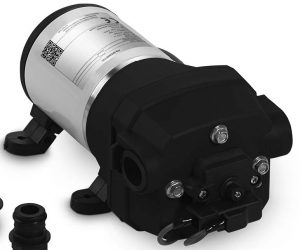
To avoid the complexities of an electrical pump (and save on power) you can consider either a hand pump or foot pump to get the water out of your tanks.
The best water pump option for Van Life in our opinion is to have an electric diaphragm pump
These pumps found in RVs, Boats, and Vans operate automatically when the faucet is opened.
If you just have a faucet and want to be really economical with water usage you can opt for a lower water flow pump.
If you want to shower or have multiple outlets in your water system, you’ll get better pressure with a larger pump.
These kinds of 12v water pumps are designed to be wired directly into your house (van) auxiliary electrical system, but we strongly recommend that you install a dedicated 12v switch on your water pump supply. There are 2 compelling reasons, firstly so you can prevent it running dry when your tank is empty (happens frequently;) and 2 if you ever get a leak you can turn off the pump quickly before it empties the entire contents of your tank into your bed (ask us how we know!)
If you want to know more about Van Life Electrical Systems – this resource will really help you!
3 More Recommendations for your 12v water pump installation
- Use an appropriate coarse pre-filter to stop particles damaging the impeller, also make sure that it is easily cleanable and accessible for maintenance.
- Install it on a solid surface and use some rubber on the mountings to help reduce vibration noise.
- Install a non-return valve (NRV) on the inlet so that it doesn’t have to work so hard to self-prime (suck up). This will help extend the life of your pump.
Pumping water around your van, truck, RV, boat.
The Importance of the Accumulator Tank
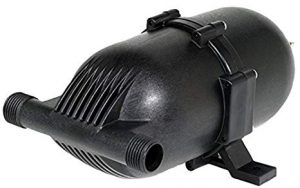
The accumulator tank is what connects directly to the outlet of the pump. It’s quite small and contains a bladder of compressed air. The accumulator tank’s job is to stop your pump from cycling on and off so frequently, it extends the life of your pump and saves on power usage. You probably don’t want to have to buy another ‘thing’ but you probably should buy this one.
After your accumulator tank, you head off to the various water systems you have, faucet, toilet, shower, outdoor shower, etc. Each branch of the water system should have a valve so that you can isolate that branch of the system for maintenance if (when) a leak occurs.
If you want to be able to turn on and off a system remotely (now you’re getting fancy) then you will need to install a water-rated solenoid, which will be either NO or NC. That is Normally Open (i want the water to stop flowing when I press a button and apply power) or Normally Closed (I want the water to flow when I press a button and apply power)
Solenoids are useful when the water system branch and manual valves are awkwardly located which is sometimes the case with tiny home living. For some, solenoids introduce another level of complexity and cost which isn’t attractive.
What is The Perfect Sink for your Custom Camper?
We really like the Dometic sinks, especially the ones with a cover over the top as it looks much tidier when not in use and creates additional useful worktop space.

If you have space, keeping the sink and stove separate will maximize the functionality and working space of your sink and stove respectively.
If you are limited on space there are some really good space-saving designs with sink/stove combo units that work great for tiny home living.
Some of these fancy designs can get quite expensive. If you’re on a budget there are cheaper options available.
Click here for more sink/stove options
Super Safe Drinking Water System for Van Life – HIGHLY RECOMMENDED!
Regardless of whether you are heading out in your adventure rig for a few days or a few months, you will almost certainly need to acquire water from different sources, that’s usually fine when you are just using it for showering or washing dishes, but not when you plan to drink it. We can never 100% guarantee the quality of the water that we obtain, even if it is advertised as portable, and because of that, we like to take our water quality assurance into our own hands.

We’ve installed a compact 2-stage water filtration system to provide us with ultra-safe drinking water. This system is designed for use with a single tank system but it can easily be adapted for use in a separate drinking water system, as we have done.
First, the water is passed through a standard inline water pre-filters which removes odor, improves the clarity, and ultimately the taste of the water – If you only have space/budget for one pre-filter, we think the charcoal pre-filter makes the biggest difference. We change these inline filters out every 6 months (based on 2 persons 1 dog usage)
The inline filter does a great job of improving the quality of the water but it can’t remove harmful pathogens such as E.coli, Legionella, or Giardia which are so small they pass right through the carbon filter.
This is why we have the ACUVA 2nd stage water sterilization unit. The ACUVA ArrowMax 2.0 uses LED UV lights to kill harmful bacteria and viruses.
This water system is one of the best modifications we’ve made to our campervan and we are absolutely stoked with the results.
Not only can we confidently get water from a much wider range of sources, but we have also eliminated our use of single-use plastic bottles and our water tastes better than ever with this system, really though, it’s the champagne of waters!
WE HIGHLY RECOMMEND THIS SYSTEM
We asked ACUVA if they could hook up Kombi Life Readers with a discount code.
You can get $50 to $150 OFF if you use the Discount Code KOMBILIFE
(We know, AWESOME DISCOUNT!)
($50 – $150 OFF WITH ACUVA DISCOUNT CODE: KOMBILIFE)
VAN LIFE ON-DEMAND HOT WATER SYSTEM!
No, what? Shut up! Hot water on demand? Now you’ll never need to live in a house again, right?!
There are a few options for having hot water on your adventure rig, so let’s break them down.
Sun Heated
You can make your own rack-mounted solar shower, or buy a ready-made Rack Mounted Solar Shower or just go for a cheap solar shower bag, either way, these are great options when the sun is shining.
The downside is that they only heat when the sun is out, which is the least of the times you need hot water. They also cool down quickly when the sun goes down.
Mounting a lot of water up high is also not a good idea as it can affect the center of gravity of the vehicle and ultimately cause handling problems or Roof Rack gutter fatigue when used off-road.
Our advice would be that these are nice to have but better to have these in addition to the options listed below.
If you are on a budget you can build your own rack-mounted shower and we show you how to do it with a video too 🙂
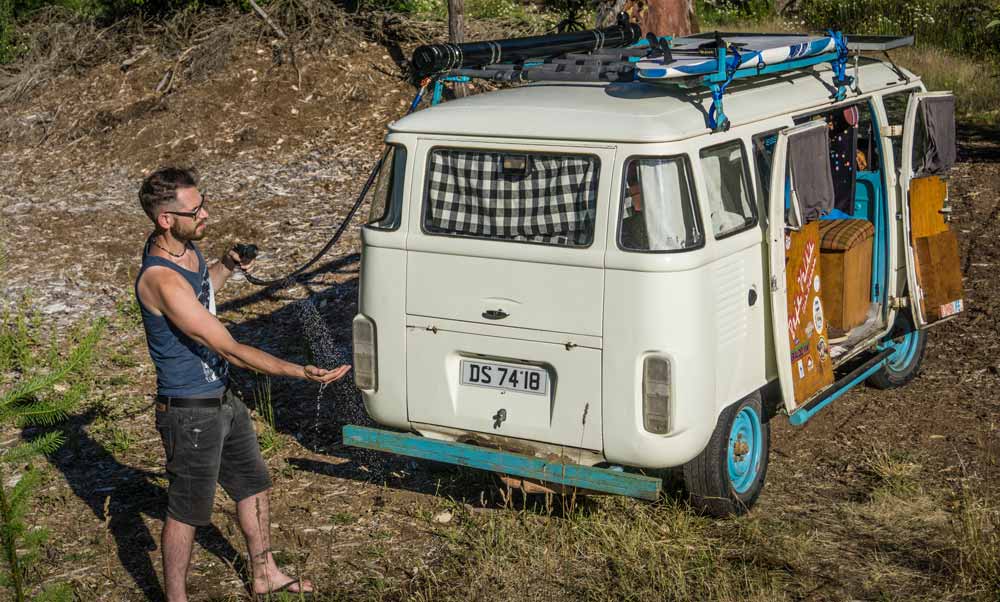
Stove Heated
The most efficient and simplest hot water system you can have is to boil water in a pot or kettle as and when you need it. It’s actually surprisingly effective and efficient. This is the option we use the most to obtain hot water in our van, even though we also have an instant hot water shower.
On-Demand Hot Water
Instant on-demand hot water systems superheat small quantities of water on their way to the faucet/shower head as it’s needed. The water is typically heated using propane. These systems do use a lot of gas/propane/LPG when compared to how much you use to cook for example. However, instant hot water from a propane shower is one of the best value-for-money forms of having a hot shower on the road.
On-demand hot water heaters shouldn’t be operated inside your campervan which is why you see most people, including us, mounting them in a semi-portable installation out the back of their vehicles. This is because they get quite hot during use and could cause a fire or noxious fumes if used in an enclosed space.
We hang our shower out the back of our van when in use and when not in use we drain the unit and store it in the back of the van.
These units operate automatically as soon as the water pressure is received at the on-demand heater, so you will want a cut-off valve or solenoid in place to stop the water from reaching the unit when not in use.
One of the best upgrades you can make to “Van Life” – check out the cost on Amazon
If your propane lines will run internally past your sleeping compartment you should install an isolation valve so that propane only reaches the unit when it is in use.
Click here to learn more about Essential Propane and LPG safety advice for Mobile Living in this video
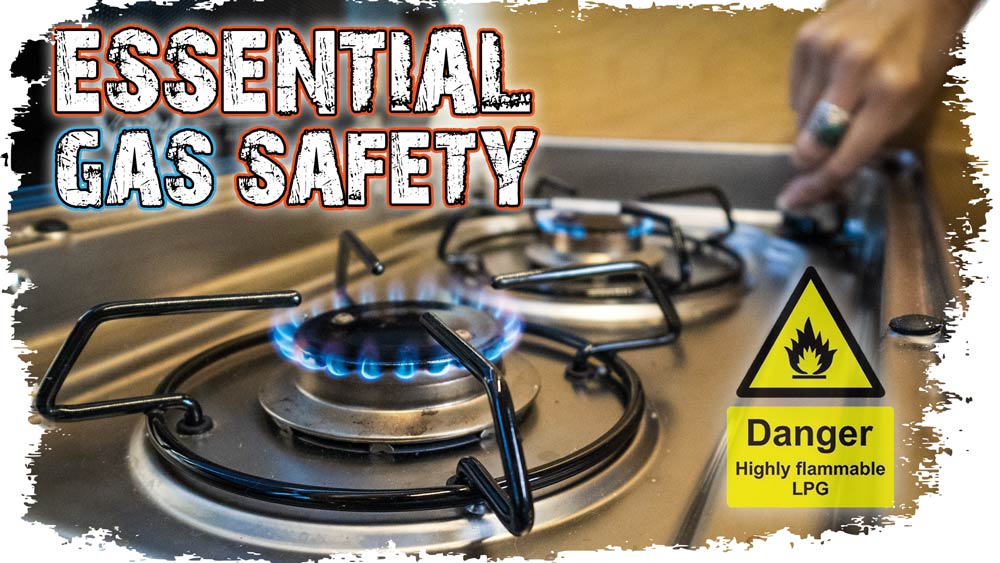
Of course, if you want to keep it simple (and there is a lot to be said for that) then maybe you don’t need hot water on demand.
There are plenty of easy shower systems that can be much cheaper too. Check out the list of Van Life Shower Options here
The Ultimate Mobile Off-Grid Hot Water System for Van Life / Overlanding and Boating
If you have space in your rig for a slightly more complex system then you have more options available to generate hot water for your mobile home. This is done in two ways, firstly by capturing excess energy in the form of heat from your engine and secondly via a dedicated heater system to heat water when you are parked off-grid and not moving.
The central component in this system is a dual-core calorifier, which is basically a dedicated hot water tank with two copper pipes running through it.
The first line is connected to the engine coolant system which passes through the water tank (or via a heat exchanger) and heats it when you are driving, which basically gives you a capacity of hot water when you arrive at camp, nice!
The second line is connected to your dedicated onboard heater system, which can be gasoline/petrol-powered but is more commonly found as diesel-powered.
This heating system provides interior climate heating via an air fan matrix and can provide hot water via a heat exchanger.
Remember you almost always mix the hot water with cold when you use it at the faucet or shower so you can get away with a smaller tank than you might imagine.
All of this takes up space so you’d better have a bigger van than we do. Don’t forget with a calorifier you will need an expansion tank to stop the pressure relief valve from leaking when the water gets up to temp.
There is some combo designed for RVs which have an integrated tank and do all of the above-mentioned heating and hot water shenanigans, they are not cheap.
Check out the Webasto Dual Top Evo.
In our opinion this is the best type of hot water system that money can buy and if you have space and more importantly the money, then you will be glad that you have this system if you’re doing extended expeditions and living on the road full time. If you’re a weekend warrior, maybe just put the kettle on? ☺️
Plumbing for camper vans and motorhomes
For most use cases people use PEX tubing for plumbing their van water systems. It does a really good job and is proven in both mobile homes and the boring static kind of homes too.
If you’re using PEX tubing you can use push-to-connect fittings which are incredibly easy to work with and we haven’t experienced any leaks in our system.
If you already have your furniture installed and must navigate some tight angles then you can use a food-grade rubber hose for your connections and barb or hose tail fittings and hose clamps, aka jubilee clips.
You’ll need to use PTFE Teflon tape on any threaded connections, and our advice is to combine it with a dab of pipe dope (aka liquid PTFE tape) to be certain that there are no leaks.
VAN LIFE WATER SYSTEM HACKS
You may wish to invest in a Silcock key for emergency situations to access water from some public water taps.
You may also wish to get a Water bandit to help you connect your hose to any type of tap/faucet that you come across.
The expandable water system for extending time off-grid. OK, they are just water bags, but they are useful and cheap.
Reduce the water you use from the faucet with water-saving aerators
Interactive Van Water System Diagram
Click on the items for more details and current prices on Amazon
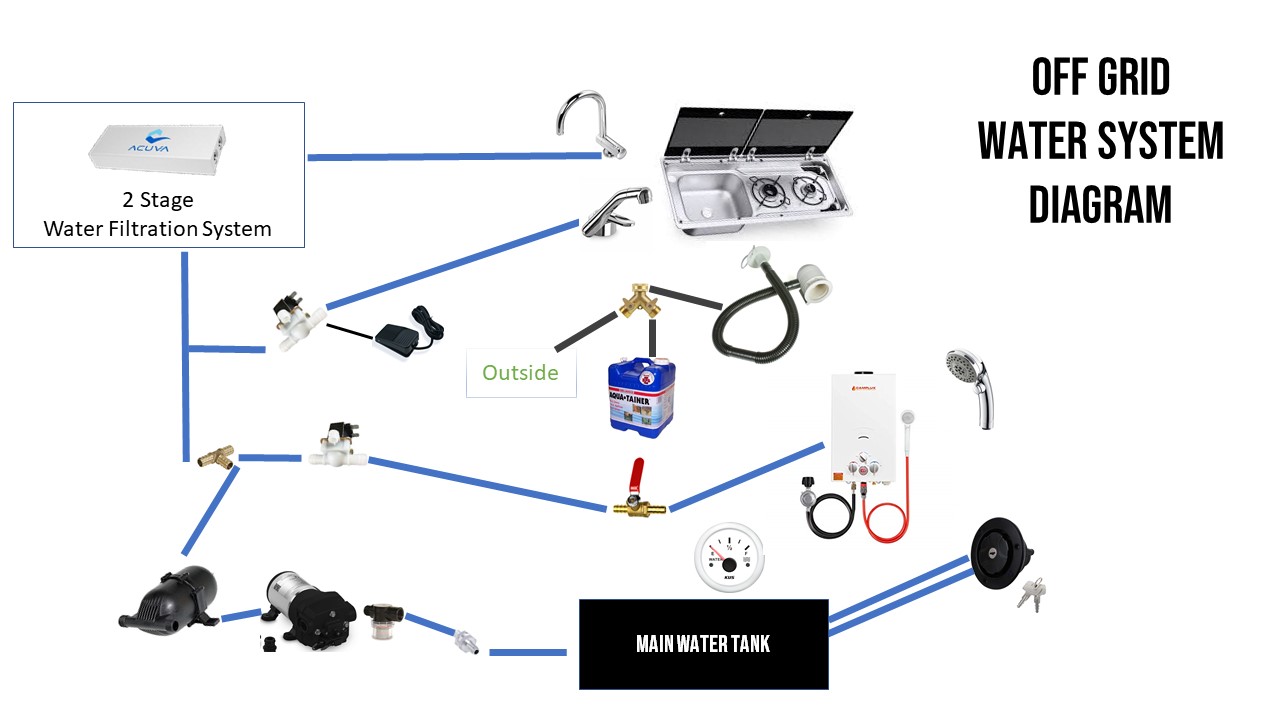
Lockable Filler Cap
Lockable Filler Cap on Amazon it has a 40mm hose and a 10mm breather for faster filling
40mm (1 1/2") Food Grade Hose
The water fill caps takes a 1.5" (40mm) food grade hose - Available on Amazon
MAIN WATER TANK (10 – 42 Gallons) (37 – 160 liters)
Food Grade Hose 13mm (1/2”)
Available on Amazon
All hoses are 1/2" (13mm) except drain hoses and the water tank fill hose
Water Level Gauge
Non Return Valve (check valve)
Coarse Filter
SHURFLO 3.0 GPM Water Pump
SHURFLO Accumulator Tank
½” Brass Tee
Water Rated Solenoid
½” Hose Check Valve
Propane Instant Hot Water Shower
Eco-Shower Head
12V Momentary Foot Switch
For Hands Free Operation of Sink. (saves a lot of water)
Available on Amazon
(We upgraded to this one which is much better than the one shown in the video)
ACUVA UV Water Filtration System
Buy From ACUVA (USE CODE KOMBILIFE for $50 - $150* OFF)
(HIGHLY RECOMMENDED FOR VAN LIFE)
*Amount of discount depends on the model chosen
Fold Down Mixer Tap / Faucet
Click Here to Choose your Sink Option
Garden Hose Y Valve
Drain hose and fitting
Drinking / Grey Water Container (7 Gallons/ 26L)
Collapsible Bucket
Van Water System Materials List
| Part | Where to Buy | Notes |
| Water Fill Inlet with Lockable Lid and breather for faster fill | Amazon | Not needed if you are filling the tank directly inside the van |
| 40mm Food Grade Pipe | Amazon | |
| MAIN WATER TANK (10 – 42 Gallons) (37 – 160 liters) | Amazon | |
| Water Gauge | Amazon or This one (better) | |
| Food Grade Hose 13mm(1/2”) | Amazon | |
| Non-Return Valve (check valve) | Amazon | |
| Coarse Filter | Amazon | |
| Water Pump | Amazon | Better than the one we installed |
| Accumulator Tank | Amazon | Not essential, but recommended |
| ½” Brass Tee | Amazon | Required if you are installing a shower system |
| Water Rated Solenoid | Amazon | You might need more than one in your rig |
| ½” Hose Check Valve | Amazon | Helps reduce flow rates for economical showering |
| Shower | Amazon | Must not be installed inside the vehicle! |
| Eco-Shower Head | Amazon | Optional |
| ACUVA UV Water Filtration System | Amazon (rarely in stock) Better direct from ACUVA (Use code KOMBILIFE to Get up to $150 OFF at checkout) | Highly Recommended! (includes smart faucet but can be used with your regular faucet if you prefer) |
| 12V Momentary Foot Switch | Amazon
| Optional: For the hands-free operation of the sink (recommended) |
| Fold-Down Mixer Tap / Faucet | Amazon | You need to connect hot to cold if you just have a cold water system |
| Collapsible Bucket | Amazon | Multi-purpose must have |
| Sink / Stove Kombi Unit | See Options Here | Ours is a Dometic 9722L |
| Drain plug | Amazon
| |
| Y Valve | Amazon | You’ll also need some barb fittings for the hoses |
| Drinking / Grey Water Container (7 Gallons/ 26L) | Amazon |
|
| 5 Micron Inline Water Filter | Amazon | For use in the ACUVA system |
| Collapsible Water Bags | Amazon | They are stronger than you’d think |
| Funnel with Filter | Amazon | |
| RV never Kink hose on a reel
| Amazon | |
| Submersible 12v Water Pump | Amazon | Optional (we use one in our 2nd water tank) |
| 12V Toggle Switch for pump cut-off | Amazon | |
| Outside Shower Upgrade | Amazon | Optional
|
| Tank Straps | Amazon | |
| Food Grade Silicone Sealant | Amazon | |
| Stainless Steel Hose Clamps | Amazon | If you are using a rubber hose |
| Water-Saving Aerators | Amazon | Optional |
| Water Bandit | Amazon | Helps you source water from a variety of faucets |
| 4-way Silcock Key | Amazon | Helps you obtain water from closed facets |
| City Water Hook-up | Amazon | For hose quick release system and campsite hookups |
| PEX Tubing | Amazon | |
| PTFE Tape | Amazon | Required for threaded connections |
| Liquid PTFE Tape | Amazon | If you want to be 100% sure of no leaks we recommend this product Here is a Food Grade Alternative Sealant |
| Hand pump faucet | Amazon | When you don’t want an electrical pump |
| Inline Filter for Filling Hose | Amazon | Allows you to attach an inline filter to your filling hose which improves water quality and helps prevent stuff “growing” in your tank |
Everything you need to know in one place to live a life of adventure off-grid and on the move
look inside this van life guide here
